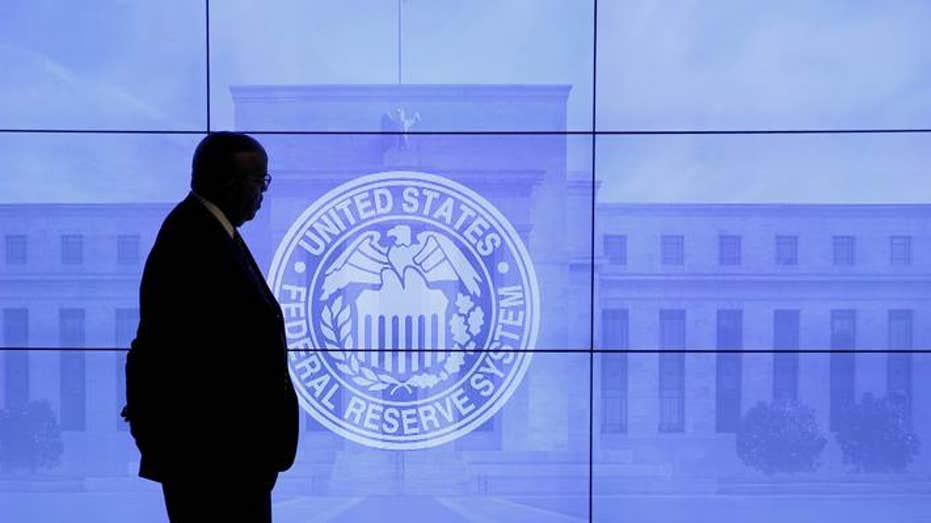Fed signals interest rate hike could come 'soon' as inflation rages
The Fed shed light on its plans to tighten policy as it combats inflation
The Fed is ‘responsible’ for volatile markets in 2022
Penn Mutual Asset Management CIO Mark Heppenstall argues there’s ‘a lot of pressure’ on Federal Reserve Chairman Jerome Powell ahead of his press conference.
The Federal Reserve on Wednesday signaled it could "soon" raise interest rates for the first time in three years, paving the way for a March liftoff as policymakers seek to keep prices under control and combat the hottest inflation in nearly four decades.
Although central bank officials have left rates unchanged since March 2020, they indicated broad support this week during a two-day, policy-setting meeting to begin aggressively normalizing policy, including raising rates amid growing concern over the rapid increase in consumer prices.
A rate increase would mark the first since December 2018.
FED STATEMENT, INFLATION UPDATE AND POWELL PRESSER: LIVE UPDATES
"With inflation well above 2% and a strong labor market, the committee expects it will soon be appropriate to raise the target range for the federal funds rate," the Fed said in its post-meeting statement. The central bank's next meeting is scheduled for March 15-16.

In this Jan. 29, 2020, file photo, Federal Reserve Chair Jerome Powell pauses during a news conference in Washington. (AP Photo/Manuel Balce Ceneta, File / AP Newsroom)
The Fed already began slowing its bond purchases last year and is on track to conclude the program in early March, allowing policymakers to begin hiking interest rates and reducing a $9 trillion balance sheet. It is unclear when the central bank will begin shrinking its bond holdings, although officials said in the statement that they would start "in a predictable manner" primarily by adjusting how much they will reinvest as their bond holdings expire.
"The committee is prepared to adjust any of the details of its approach to reducing the size of the balance sheet in light of economic and financial developments," the Fed said in a separate statement outlining "principles for reducing the size of the balance sheet."
For months, the Fed has been wrestling with its dual mandate of stable prices and full employment. But the nation's jobless rate plunged to 3.9% in December, down from a pandemic high of 14.7%, while consumer prices surged 7.1% from a year ago, marking the fastest pace for inflation since 1982 as consumer demand confronts a shortage of goods caused by congested ports and other pandemic-induced disruptions in the supply chain.
"I would say, and this view is widely held on the committee, both sides of the mandate are calling for us to move steadily away from the very highly accommodative policies we put in place during the challenging conditions that the economy faced earlier in the pandemic," Chairman Jerome Powell told reporters during a post-meeting press conference. "Most FOMC participants agree that labor market conditions are consistent with maximum employment."

This May 4, 2021, file photo shows the Federal Reserve building in Washington. (Associated Press)
Most economists expect the Fed to raise rates four times this year. Traders are already pricing in a more than 90% chance of a rate increase during the Fed's mid-March meeting, and a roughly 65% chance of four hikes over the course of the year, according to the CME Group, which tracks trading.
Some economists believe the Fed waited too long to confront the burst in inflation, while others have expressed concerns that moving too quickly to stabilize prices risks slowing hiring and potentially leaving many workers, particularly lower-income Americans, without a job. Hiking interest rates tends to create higher rates on consumers and business loans, which slows the economy by forcing employers to cut back on spending.
Powell said that it's difficult to determine what pace of rate increases is needed to cool inflation without strangling the economy but said it's important to be "humble and nimble."
"We’re going to be led by the incoming data and the evolving outlook," he said.

A security guard walks in front of an image of the Federal Reserve following the two-day Federal Open Market Committee (FOMC) policy meeting in Washington, D.C., March 16, 2016. (REUTERS/Kevin Lamarque/File Photo)
GET FOX BUSINESS ON THE GO BY CLICKING HERE
The central bank has been gradually setting the scene for at least one rate hike in 2022 as it unwinds the ultra-easy policies put in place to prop up the economy in 2020 after the coronavirus pandemic began. The prospect of multiple rate hikes this year, however, has rattled financial markets, with the Dow Jones Industrial Average whipsawing more than 1,000 points this week.
"From here forward, investors should expect each FOMC meeting to be considered 'live' from the perspective that rate hikes are now on the table," said Jason Pride, chief investment officer of private wealth at Glenmede.





















